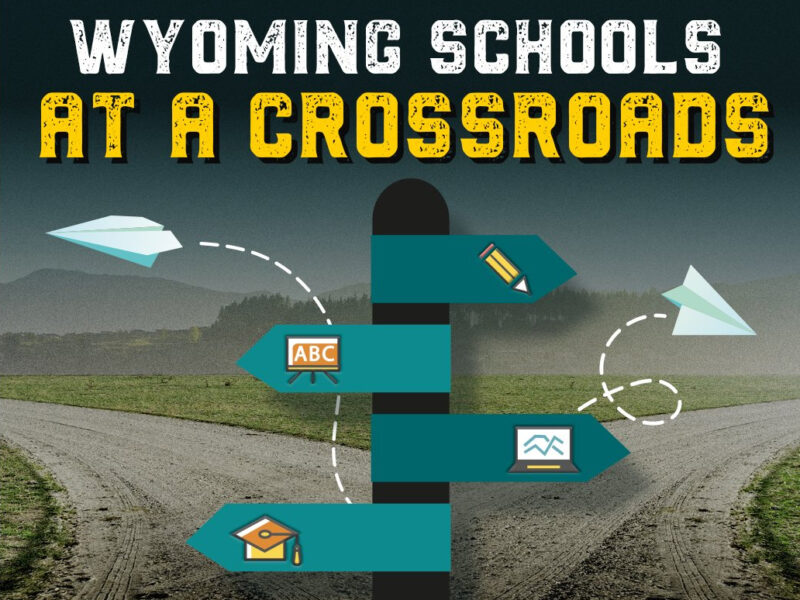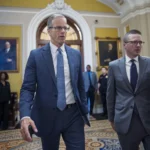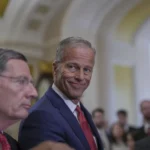WYOMING SCHOOLS AT A CROSSROADS: Teachers See Resilience in Students Since COVID-19 Outbreak, But Social Struggles for Preschoolers (Part 1)
Schools weathered pandemic uncertainty yet now face lingering challenges
- Published In: Other News & Features
- Last Updated: Mar 15, 2023

By Elizabeth Sampson
Special to the Wyoming Truth
For many, it was the spring break that stretched into fall. For others, it was the first time they attended school on the couch in their pajamas. For everyone, it was an unprecedented time that found teachers juggling new technology to connect with their students, parents struggling to help their children with math methods they had never learned and children wondering if they would ever play with their friends again.
This was education during the COVID-19 pandemic. On March 15, 2020, Gov. Mark Gordon recommended schools close until at least April 3 in response to the rapid spread of COVID-19 nationwide. Each school district wrestled with the heavy decision of what was best for its community, with most districts closing from March 16 through the end of the 2020 school year.
Though Wyoming students returned to in-person learning that fall—much sooner than students in many other states—educators say they still endured the impacts of the pandemic’s early isolation and uncertainty, followed by community division on how to handle the return to the classroom.
Now, three years later, some educators say their students are experiencing challenges that go beyond a dip in test scores—diminished social interactions and more anxiety, digital device dependence and learning gaps.
The Wyoming Truth spoke with preschool through college-level educators from across the state who believe some of these challenges were brought on by the pandemic, but also claim the pandemic simply shone a light on other issues students already faced.
Still, these Wyoming educators are encouraged by students’ resiliency, compassion for each other and willingness to speak up for what they believe in.
Join the Wyoming Truth for a four-part question-and-answer series exploring the pandemic’s lasting impacts on students and teachers’ hopes for their futures.
First up is a conversation about how the pandemic affected the state’s youngest students—preschoolers ages 3 to 5—who now grapple with delayed social skills.
Some of Wyoming’s preschool students were born right as COVID-19 was reaching the state. And that’s had an impact on their behavior and learning styles.

Dee Buckstaff opened her first preschool in 1994 and now owns Montessori School of the Tetons in Jackson. Nicole Philbin has worked at Jackson’s Children’s Learning Center preschool for nearly 14 years. Both educators say some methods that were used to protect young children—like social distancing—might still be a factor in how they view their world.
When you think about students pre-COVID versus now, have you observed any behavior differences?
Buckstaff: The most heartbreaking thing is to see children come in who haven’t had the play dates and going to the park and hanging out with people, so they’re just hanging on the edge of the group. They’re standing back about four or five feet. The body language says, “I have no idea what to do to join that group over there even though that’s what I really desire.”
Some of the play is very interesting these days compared to 20 years ago. I’ve had children pick up a play cutting board, and they’ll sit there and they will stare at this piece of wood. It is a blank piece of wood. I’ll go, “What are you doing?” And they will say, “I’m playing on my iPad” or “I’m calling someone on my phone.” Is that inventive or is that just sad?
Philbin: A lot of kids that we have gotten in the last couple of years were really isolated during their first few years of life. Babies that were born during the pandemic, moms were not doing mommy-and-me groups or taking them to childcare when they were little or getting together with friends. You can sometimes tell that being in these larger group settings with a bunch of other kids feels really overwhelming for some of these little ones …That’s starting to level out now. But right after the pandemic, I think that not having those social interactions can show up as a speech delay in kids.
What else have you noticed about your current students?
Buckstaff: I see, in general, the children we have need to move more. They don’t have the concentration skills. There’s all kinds of theories out there that contribute to that. It’s not necessarily COVID-related, but I’ve noticed that. A lot of them aren’t as engaged with storytelling. It’s more like they are looking inside themselves instead of paying attention to things outside of them.
Philbin: One of the things that we’ve seen, for sure, is there’s been a huge spike in stress in families. Early in the pandemic, people might have not been able to work. Or they were really scared of the consequences of the virus and unsure if the world was a safe place for them, and it manifested in a lot of home stress. Since then, we’ve seen huge increases in housing prices in Teton County. The inflation has been crazy, so a lot of families have had to work more. What we’re seeing in our kids, as a result of those peripheral consequences of the pandemic, have been behavioral challenges, and I imagine it’s because the home life is pretty stressful in some ways.

How is their mental health? Are you seeing more anxiety or depression?
Buckstaff: We have a few kids who are very much attached to wearing a mask. It’s been hard for them to not wear a mask. I think it’s that security thing. We would say, “You need to keep your mask on. We’re going to try to keep our friends from getting sick, and we want to keep you from getting sick.” All the societal fear about losing somebody or really getting sick has definitely translated to these little guys.
Philbin: More challenging behavior stuff like not following directions, having tantrums, kind of big emotional reactions to certain things in the classroom. We are a fully inclusive program and provide those special-ed services, so that’s something we’ve always had as a part of our program. But we saw a little uptick during and right after the pandemic.
What strengths have you noticed in these students?
Buckstaff: They are champion hand washers. They are more aware of people who are sick. They will come and say, “Miss Dee, so and so coughed on that.” They know we pick up that toy and wash it.
Some kids, when they have had more time with their parents, have actually increased their academic skills. We’ve had more children who were reading on their own by the time they were 4-and-half and 5 years old two years ago than we ever had before.
Philbin: We had a period of time in our early days of reopening that kids had to sanitize every toy they touched before they put it back. It took a little bit of management in the beginning, but they just fell into practice. They were flexible and resilient and kind to their friends in those moments, being able to support one another and remind one another about what we do.
Did you make any changes regarding classroom management?
Buckstaff: We’ve always been very careful about keeping things clean, but I would say we are much more aware and do it daily. . . . There were some days where we used to go, “This kid stayed late. If I get into cleaning everything, it’s going to take me another 35 minutes…” Now we definitely stay and spend the 35 extra minutes.
Philbin: I agree that some of the things that stuck are additional cleaning and sanitizing. We still sanitize doorknobs, keyboards and that sort of thing when we didn’t really worry about that pre-pandemic. We also keep a stricter illness policy. We are far less likely to have children who don’t feel well at school . . . .
What do you hope or fear as we look to their future?
Buckstaff: That their social and emotional development doesn’t lag for too long. I have hope they can catch up. I think the more opportunities we can give kids to play outside and to play with each other and not sit in front of a laptop, the better off they are going to be. I hope all of us can get to the point where we can relax a little bit and not be so hyper-vigilant about germs and catching things.
Philbin: The fear that comes to mind is I’ve heard a lot of kids mimicking some of those really intense opinions that come out of the household. I do think it came up through the pandemic because of all the fear and anxiety in the world at that time. Sometimes it can be really kind of ugly to one another. That worries me about all our future generations after such an intense time that we’ve all come through.
I honestly do not have a huge worry about the loss of learning. I do worry about some delays that could come up as a result of that home stress. Hopefully, there will be resources for them and their families as they move through whatever school system they choose.
What do you hope people will understand about this generation?
Buckstaff: I would like to see people just be kind and understanding with these kids, because I think we’re probably going to see some differences throughout their entire educational life. I think that we just have to understand that they were born into this craziness that none of us had ever been through before.
Philbin: Flexibility and resilience [are] really powerful and will serve these kids really well as they continue with their life. Hopefully that’s something they can carry with them.
Check back for part two, a conversation with elementary and middle school teachers.













